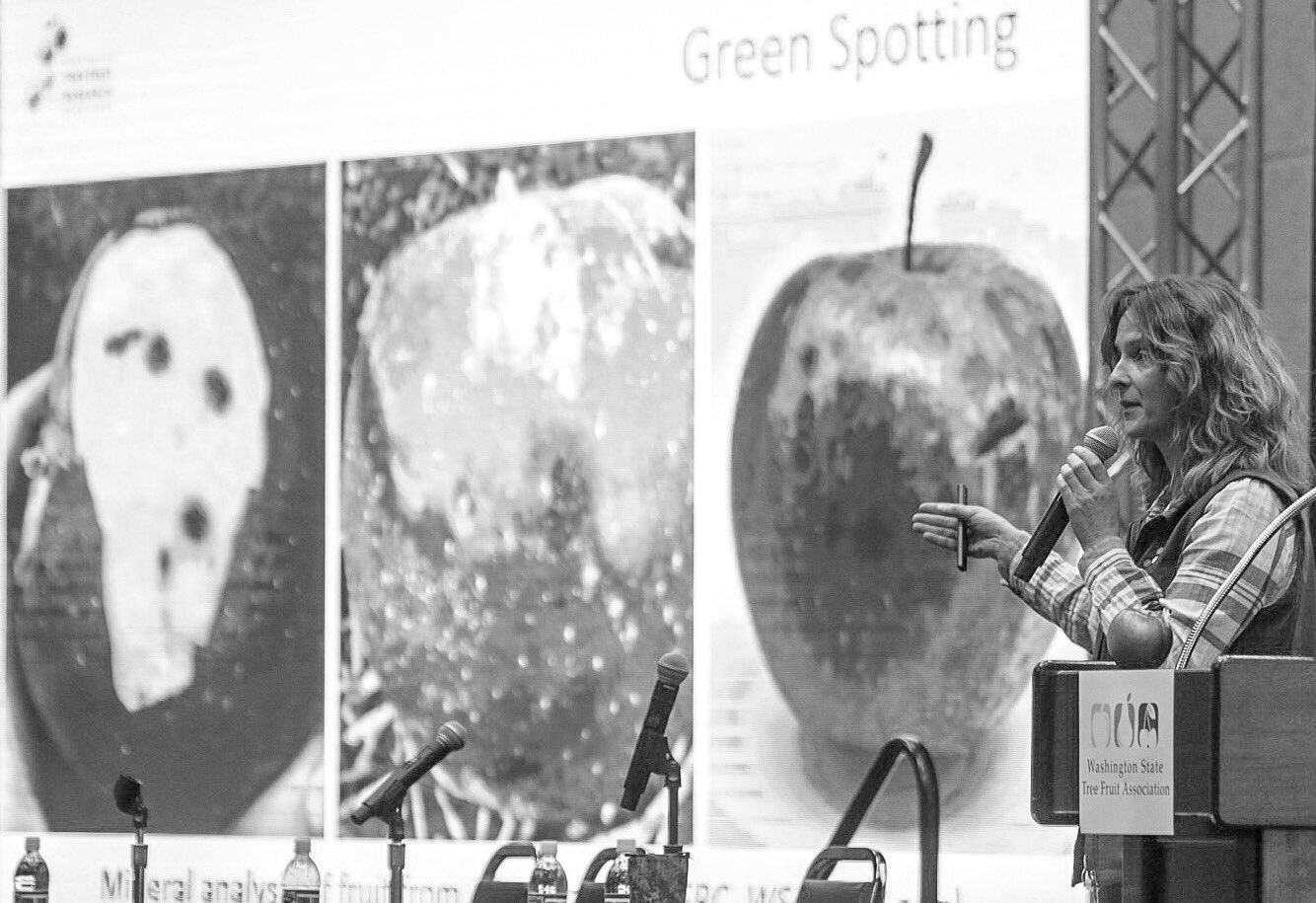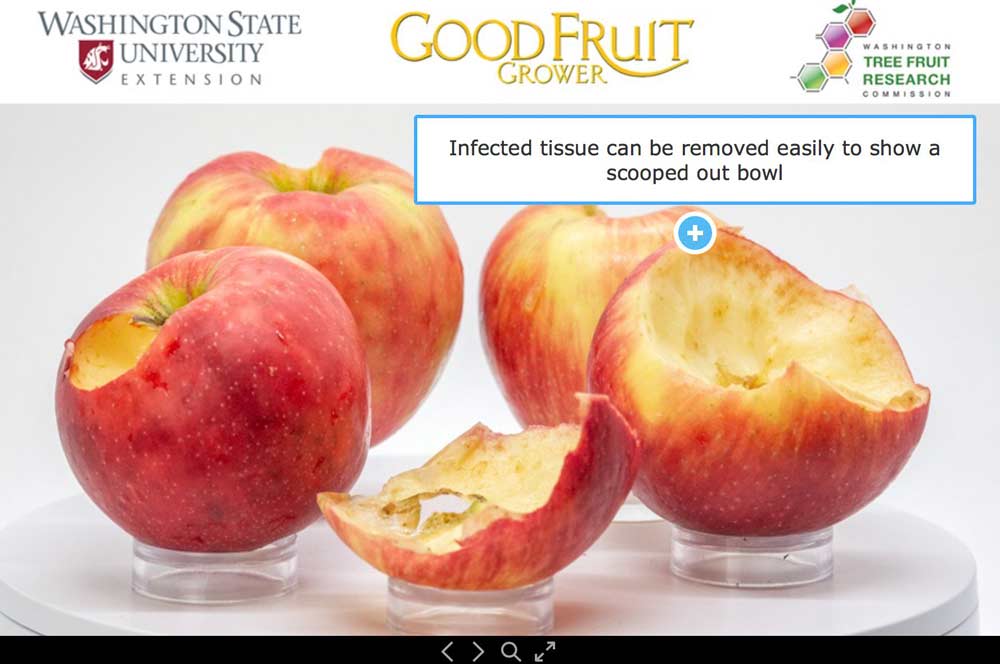
Ines Hanrahan, executive director of the Washington Tree Fruit Research Commission, talks about green spotting of WA 38/Cosmic Crisp at a WSU research orchard during the final sessions at the Washington State Tree Fruit Association Annual Meeting and Hort Show in Yakima on Dec. 5, 2018. Learn more about this in a story by Ross Courtney. Go to https://goodfruit.com/cosmic-conundrum-whats-behind-these-spots(TJ Mullinax/Good Fruit Grower)
WA 38, the new Washington State University apple variety to be sold under the brand name Cosmic Crisp, took center stage Wednesday for an entire session, closing out the Washington State Tree Fruit Association annual meeting.
Talks ranged from horticultural topics, such as managing nutrition and vigor, to the standards and marketing for a variety that is expected to produce the first fruit for consumers next fall.
WSU has contracted with Proprietary Variety Management to handle the commercial rollout of WA 38. The two entities had already announced a $10.5 million, five-year marketing campaign intended to raise awareness and generate consumer excitement about the new apple. The stakes are high: an estimated 12 million trees are likely to be planted by 2020, with production projected to top 20 million boxes six years later — and to continue to increase from there.
Assuming a planting cost of $45,000 per acre, industry investment is projected to top $500 million by 2020, said Lynnell Brandt, president of Proprietary Variety Management.
And the variety faces plenty of competition from other products and apple varieties already in the market, he said. “We need to create a connection between this product and the consumer so that they can go back to it,” he said. “We have a lot of competition, a lot of things that are in the pipeline or are there already, all with their own focus, with their own challenges, with their own aspirations.”
The campaign is being funded from royalties on tree, budwood and, eventually, fruit sales. Growers pay a $1 per tree royalty on every WA 38 tree purchased, with 65 percent going to WSU and 35 percent being split between participating nurseries and PVM. Fruit royalties have been set at 4.75 percent on every box, but only when the price tops $20 per box. Twenty-five percent goes to PVM, and 75 percent goes to WSU.
Brandt declined to provide the breakdown of how much WSU and PVM are contributing to the campaign, which is being fully funded by the two entities’ royalties. But each entity’s percentage is in line with the percentage of royalties each will receive, he said.
Also key to the rollout will be ensuring high returns for growers, said Scot Hulbert, interim associate dean for research at WSU’s College of Agricultural, Human and Natural Resource Sciences. “Good prices will be essential to the producers who have made huge investments, hundreds of millions of dollars,” he said. “When we decided to do this, when we’re talking to the president, to the deans, we’ve said we really don’t want this to come out and lay an egg. We want this to be Washington’s next big apple.”
On the horticultural side, grower Tom Auvil encouraged growers to try out multiple rootstocks in their blocks. He also urged growers to remember that 50 percent of the WA 38 crop appears on one-year wood and will be an important part of the crop. In addition, 40 to 50 percent of the fruit sites will fall off and not set, he said, so growers need twice as many fruit sites, “and you can’t get there with pruning.”
“Tipping one-year wood on vigorous trees will delay yield. It will also remove most of the crop,” he said.
Researchers haven’t yet identified the exact starch range to determine the ultimate time to pick the variety, but growers should plan to harvest when the fruit is between 2.5 to 4.5 on the scale, said Ines Hanrahan, executive director of the Washington Tree Fruit Research Commission.
Auvil also recommended growers hold off on shipping any fruit until the first week of December, after holding the fruit at room temperature in pre-shipping for a week to 10 days to reduce the acidity and convert the starch to sugar.
On a question related to the “greasiness” of the variety, Hanrahan acknowledged that late maturing fruit can get greasy, but said, “It hasn’t been a problem when we’ve run it over a commercial packing line. It cleaned up.”
A final look at WSTFA 2018

Jon DeVaney (left) and Tim Kovis make the rounds after the hort show sessions draw to a close on Dec. 5, 2018, concluding the 114th annual meeting and trade show in Yakima, Wash. (TJ Mulllinax/Good Fruit Grower)

Good Fruit Grower staff memberes Maria Fernandez (left) and Rick Larsen greeted visitors at the Good Fruit Grower booth at the Washington State Tree Fruit Association annual meeting in Yakima, Washington, Dec. 3, 4 and 5, 2018. (TJ Mullinax/Good Fruit Grower)

Hate bad apples? Then you will love seeing some of the worst examples of your favorite varieties in this tease from the future Apple Disorder Guide from WSU Tree Fruit Research and Extension, Washington Tree Fruit Research Commission and Good Fruit Grower. The guide was featured in a hort show session on Dec. 03. (TJ Mullinax/Good Fruit Grower)






Leave A Comment